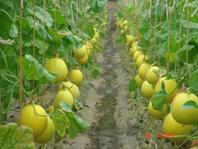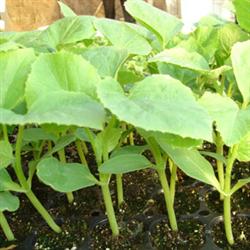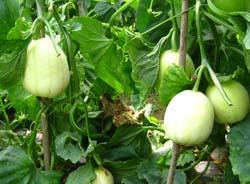High-yield and high-efficiency cultivation of muskmelon in cold shed

Thin-skinned muskmelon has always been the cultivation method of climbing vines on the ground, which is disorderly interspersed with melons, which is difficult to manage and the yield is low. The thin-skinned muskmelon was cultivated in the cold greenhouse, just like the cucumber in the greenhouse, the method of hanging vine was adopted, and the higher yield and economic benefit were obtained. The average yield was 667m2, the yield of muskmelon was more than 5000 kg, and the net benefit was 10000kg / 11000 yuan. 1. The construction sample of the greenhouse should be in harmony with the melon cultivation model. The greenhouse is bamboo and wood structure. Before freezing in the first year, the skeleton of the greenhouse is built, the north-south direction is better, and the ridge direction in the greenhouse is north-south; the east-west direction is also possible, and the ridge direction in the greenhouse is east-west. Shed parameters: the height of the middle ridge is 200 cm, the height of both sides is 190 cm, the width is 12 meters, the length can be self-defined, generally 80 meters and 100 meters long is better. The column in the shed has a row spacing of 160 cm (equal to the width of the "microfilm" covered in the shed, in order to cover the "microfilm" between the rows of the columns in the future). The column spacing is 100 cm (equal to the melon row spacing, in case the melon seedlings are planted in a straight line with the posts, that is, the posts are located on the melon ridge). In order to improve the ground temperature, PVC drip-free greenhouse film should be buckled as early as possible. After the melon seedlings are planted, grass curtains should be pasted around the outside of the greenhouse, and two layers of "microfilm" should be laid inside to make it a greenhouse covered with three films. The microfilm is a light blue film with a width of 160cm and a thickness of 0.008 cm. The method of laying "microfilm": above the greenhouse column, 10 cm away from the greenhouse film, consistent with the muskmelon ridge direction, pull a piece of wire every 100 cm, the wire is fixed on the column, and the wire is exactly aimed at the melon ridge below. In the future, flies are tied to the wire to hang vines. The wire is covered with a "microfilm" (perpendicular to the direction of the wire). At 10 cm below the first layer of microfilm. Then pull the wire, and then cover the second layer of "microfilm". Between the "microfilm" and "microfilm" of each layer, clamp it firmly with a small clamp, take it off during the release, and sew it to release the air. PVC greenhouse film, the top (middle ridge) and the upper part of the skirt on both sides, leave three air seams, usually closed, open. Apply more than 5000 kg of rotten organic fertilizer, 50 kg of diammonium phosphate and 30 kg of potassium sulfate, combined with deep ploughing to turn 60% of the chemical fertilizer into the soil together with crude fertilizer. Therefore, in the direction of the greenhouse, trench is opened according to the row spacing of 100 cm, and the remaining chemical fertilizer is applied in the furrow, and then a high ridge with a height of 15 cm and a width of 40 cm is made, leaving a ridge furrow of 60 cm between the two ridges for watering and management. After ridging, cover with white plastic film. Third, raising seedlings on January 20th, that is, before and after Greater Cold raising seedlings, we should master the following links. 1. The nutritious soil is used to prepare farm manure and half of the fertile soil that has not been planted with melons and legumes. Add 2 kg of Sakefu compound fertilizer to each cubic meter of nutritious soil, mix well, sift, and put into a nutrition bowl of 8 cm × 10 cm. two。 Hongcheng 7 or Jitian muskmelon varieties were selected for seed soaking and sprouting. The seeds were soaked in 12-15 ℃ cold water for 1 hour, and then soaked in 800-fold chlorothalonil or 300-fold watermelon stubble for 5 hours. Rinse with cold water and sprout in 25: 30 ℃. After sprouting, the buds were refined at low temperature at 10-15 ℃. 3. Sowing and seedling management 2 seeds flat in each nutrition bowl, covered with 1 cm fine soil, covered with small arch shed and grass curtain to warm and moisturize, 25: 30 ℃ during the day, 20: 22 ℃ at night before emergence, 25: 28 ℃ during the day and 15: 18 ℃ at night after emergence, keeping humidity above 90%. The seedlings were planted in time, when the seedlings grew to 2-3 true leaves, the film was opened and the seedlings grew 3-4 pieces and 1 core. 4. Planting and management after planting in late February, one row was planted in each high ridge, the row spacing was 100cm, the plant spacing was 25cm, and the density was 2678 plants / 667m2. 1. After temperature and humidity control, the closed greenhouse was 25: 32 ℃ in daytime, not less than 15 ℃ at night, 24: 30 ℃ in daytime, 15: 18 ℃ in night, 28-32 ℃ in daytime and no less than 16 ℃ in night after melon sitting. When the temperature is high, the air is cooled and dehumidified, keeping the temperature 60%-70%. Once hit by the cold spell, the seedlings will not be frozen and happy when there is a short low temperature of 2 ℃ in the shed. two。 5-7 days after fertilizer and water management planting, choose sunny day to pour slow seedling water. Early moisture should not be most, in order to prevent overgrowth and falling flowers and fruits. During the fruit expansion period, there should be adequate water supply. When melons grow to the size of eggs, follow 667 square meters of water to chase 10 kilograms of urea. After sitting down with each stubble of melons, pursue 5 kilograms of urea and 5 kilograms of potassium sulfate. Be careful not to water the melon within 7-10 days before harvest to prevent cracking. 3. Single vine pruning when the main vine grows 6-7 leaves, each plant is fixed to the upper wire with a rope, and the 10-centimeter-long stick is inserted into the ground, tightening the rope and winding the vine around the rope (the same as the greenhouse cucumber hanging vine). There is an axillary bud in the axilla of each leaf (if it is allowed to grow, it will grow into a lateral vine). First, wipe off the axillary buds of two leaves near the ground, retain the axillary buds of the third to seventh leaves, and wait for the axillary buds to grow into the first leaf. when a small melon grows in the axilla, pinch off the front leaf of the melon, leaving only one leaf and one melon; the axillary buds of the third to seventh leaves are all such a whole branch. After fruiting melon, choose to leave melon stalk thick, melon shape is positive Dinggua 3 4. The main vine continues to grow, pinching when it reaches the top of the shed. At this time, live and apply from the top, leaving 3-4 axillary buds, axillary buds pruning the same as before, and then 2-3 melons. The rest of the axillary buds were erased as they grew. Each plant bears two crops of melons, usually 5 or 7 melons. 4. The tip of the brush for artificial pollination is dipped on the male flower, and then the pollen is placed on the stigma of the female flower; you can also spray the female flower core with a small sprayer with 1000 grams of water in 5 milliliters, paying attention to spraying it on the same day or the next day when the female flower blooms. In order to prevent repeated spray flowers, and the emergence of split gourd, balsam pear, deformed melon phenomenon, you can add some pigments in the liquid medicine as a mark. This method is simple, easy to operate, and has the advantages of high melon setting rate, large melon feet, high speed, early maturity and high yield. Fifth, prevention and control of diseases and insect pests. When sowing, 1 part of copper sulfate fine powder, 1 part of quicklime powder and 100 parts of fine soil were evenly mixed to cover the seeding bed, downy mildew was controlled with aluminum ethyl phosphate or pyrethromycete, powdery mildew was controlled with thiophanate methyl or strychnine, and Fusarium wilt was irrigated or sprayed with thiophanate methyl. Aphids, whitefly, red spider, etc., were controlled by 17% aphid mites aerosol.
- Prev

Sowing method of muskmelon in open field
Open-field muskmelon sowing method: open-field muskmelon is cultivated in dry ponds covered with plastic film. Generally, the pond is 0.5 meters wide, 1.5-1.8 meters deep and 20 centimeters deep to the north and south. Before ridging, a small ploughing trench (8-10 centimeters) is applied on both sides of the dry pond 30 centimeters away from the edge of the ridge.
- Next

Pruning method of thick-skinned melon
The main results are as follows: 1. in the pruning mode of mid-early-maturing varieties, the single fruit weight of mid-early-maturing varieties is generally less than 1.5 kg, and the mature period is 35-42 days. According to the different cultivation season and environment, the following pruning methods can be adopted. The main results are as follows: 1. Cultivation in winter and spring in greenhouse. Generally use the mother vine as the main vine, single vine double-layer melon way, that is.
Related
- Moge, come on! The staff of the peasant association in the producing area of cantaloupe were frightened when the crowd gathered.
- Causes and Solutions of low Fruit setting rate of Apple
- Symptoms and control measures of passion fruit virus disease
- Fruit growing lesson: how do apple orchards keep high yields?
- Can you build orchards in the mountains? What are the pros and cons?
- How to manage the coloring period of Crisson grape?
- This paper introduces the processing technology of two kinds of fig products.
- How much is a month for retired teachers in rural areas by 2020?
- How can strawberry planting increase sugar content? We should pay attention to management in many aspects.
- What are the cultivation techniques on how to improve the yield of golden fruit?

